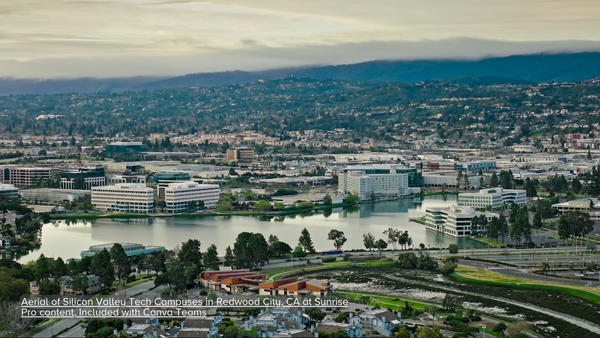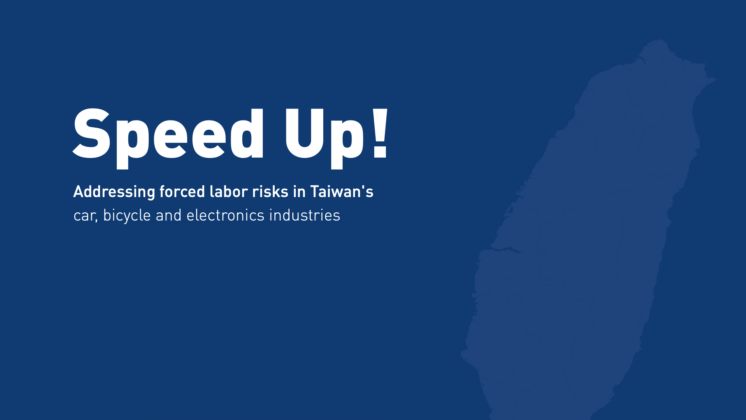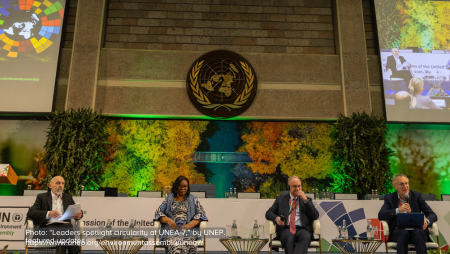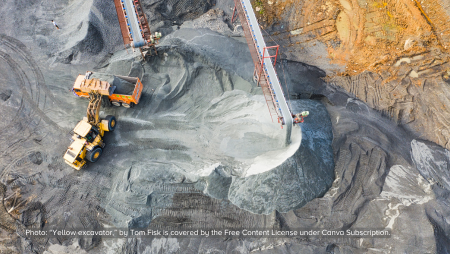An article by Aloys Tegera of the Goma-based Pole Institute about the collapse of the local economy in Eastern DR Congo as a result of the decision of President Kabila to suspend mining activities in that region. Tegera points out that artisanal miners are the hardest hit, but mineral trading firms and the local administration also lose out on income.
THE IMPACT OF THE SUSPENSION OF ARTISANAL MINING IN EASTERN DRC
His name is Sengi, and he manages the office of an air transport company, Goma Express, which does the local flights between the town of Goma and the isolated rural areas of the territory of Walikale and the province of Maniema. His schedule of local flights to Walikale is empty. His company previously managed to do eight flights per day.
After the presidential decision of 9 September 2010 to suspend mining activities in the Kivus (Eastern DRC) the company was reduced to making 4 flights per day for the first few days following the announcement, but today there are none at all. His cargo mostly consisted of basic commodities and foodstuffs like sugar and salt, and also cash crops like beans, maize, potatoes and cassava. These foodstuffs were mostly for the sustenance of the artisanal miners in the mining camps of Bisie and Omate in the territory of Walikale, as well as in the business centres of Kilambo, Mubi and Ndjingala.
The majority of miners, estimated to be about 30 000 in the mining camp of Bisie alone, dispersed in various direction after the closure of the mines, and the cost of living has naturally risen for the local people of Walikale who remained behind. For the traders who chartered Antonov cargo planes the cost per kilogramme of transporting merchandize has risen sharply from 50 cents to US$ 1. This is because the minerals transported on the Walikale-Goma route are blocked.
Issa is the father of six children. He is the owner of a depot that the traders use for the transit of their products to and from Walikale. Today he is unemployed and unable to pay school fees for his children who have since been dismissed from school. His workers at the depot who used to get between $5 and $20 a day are also unemployed, unable to feed their families that depended on their daily wages.
Goretti and her husband are in a similar situation. They are owners of a shop that sells motorbike parts that they buy from Dubai or China, which they re-sell in the rural areas of Walikale and Maniema. Their sales have plummeted. They hope that the presidential order that suspended mining activity on 9 September will be lifted, otherwise their business will not be saved from total collapse.
As for Birere in Goma, a crossroads market place connected via a small border post to the Rwandan town of Gisenyi, all commercial activity slowed down significantly, from the motorcycle ‘taxis’ to the sellers of subsistence crops. The co-operative of women of North Kivu (COFENOKI, which later became AVEPAD) with a membership of mainly 1200 women and about 50 men, deals in subsistence products from the territories of Masisi and Rutshuru.
Depending on the farming season, these women receive thousands of tonnes of beans, maize, cassava, soya and potatoes. They re-sell these to markets throughout South Kivu, Maniema, Kisangani, Lubumbashi and Kinshasa, or in Gisenyi in Rwanda. At the end of August 2010, a bag of 100 kgs of beans sold for $48, and by September 2010 it had gone down to $42. These women traders of subsistence crops estimate that the free fall in food prices will continue for as long as the suspension of mining activities in the Eastern DRC is in force.
For these women, the minerals inject fresh money into the local economy, and the great majority of their clients are women who supply the mining camps of South Kivu. The latter women buy thousands of tonnes of beans, maize and cassava and feed not only the people of the town of Bukavu but also the artisanal miners in the mining camps of Mwenga and Shabunda.
The collapse of the local economy is mainly due to the decision of President Kabila to suspend mining activities in Eastern DRC during his short address of 9 September 2010 in Goma.
1. A courageous but disastrous decision
President Joseph Kabila is well known for his silence and economy of words. The people of Goma present at his short address on 9 September 2010 at the Ihusi hotel saw a confident Kabila, announcing decisions that were not only courageous but also disastrous if applied.
This had to do with the suspension of the mining of minerals in Eastern DRC, promulgated by his minister of Mines on 20 September 2010, the change of command in the 8th military region in the week that followed, as well as the relocation of the CNDP integrated into the FARDC throughout the other provinces of the country.
The question asked by critical observers was whether President Kabila had at his disposal the means necessary to effect his decisions. In this paper our analysis is limited to the impact of his decision on the mining industry in Eastern DRC.
2. Wading through the quagmire
For an economic sector known for its importance in view of the returns from mining products which represent two-thirds of the official revenues of the province of North Kivu, the suspension of mining activities in Eastern DRC is comparable to a sufferer of a respiratorial illness from whom the oxygen mask is suddenly snatched away. Though President Kabila played down the contribution of the mining sector to the national treasury, because of the state of the roads in Goma, the minerals constitute the main artery of the formal and informal economy, as well as the subsistence economy of thousands of households in Eastern DRC.
Besides the local air transport, trade in subsistence crops and other foodstuffs noted above, the absence of millions of dollars in circulation generated by the minerals trade affects many sectors of the local economy in the grip of a global financial crisis whose repercussions are beginning to be felt everywhere.
Many people are also afraid that among the thousands of artisanal miners who left Walikale for the towns of Goma and Kisangani there are former militia members who might rejoined their former armed groups to live by the Kalachnikovs they had previously abandoned.
There is no doubt that besides these artisanal miners there are many other victims of the presidential decision. The majority of closed mineral trading firms are not able to export their stockpiles.
According to the Division of Mines of North Kivu, the stockpile of minerals not yet sold is estimated at 1 019 936 kgs of cassiterite, 68 794 kgs of coltan, 13 010 kgs of wolframite, and 27 730 kgs of slag. A number of traders are not able to honour their debts to their external partners who advanced them capital.
For the local administration, the loss of income from taxes levied on aerial transport of minerals and export duties are important. The loss of a variety of other taxes paid to specialised government services is also not negligible.
In a memorandum addressed to the President of the Republic by the Federation of Companies of North Kivu (FEC), the operators estimated that the amount of taxes that they pay per month to the national treasury at $1 892 240. This is a substantial loss. If the unavailable figures of the provinces of South Kivu and Maniema are added to this figure, the operators estimate that at least $3 to $4 million is paid per month to the various departments of the local administration.
The presidential decision came at a time when many national and international initiatives are being taken to render the artisanal mining of Eastern DRC more transparent and accountability in the chain of supply more reliable. Following upon numerous reports by non-governmental organizations and international lobbies which described artisanal mining in Eastern DRC as “blood minerals”, the initiatives to clean up the industry have increased.
This relates, in particular, to the system of certification of minerals by the German Bureau of Geo-sciences and natural resources (BGR) and to the tagging certifying the origin of these minerals set in place by ITRI (International Tin Research Institute) through its ITSCI (International Tin Supply Chain Initiative).
The Germans seem less concerned by the ban, in the hope that it would not last long, but mineral tagging for export is no longer carried out. At the local level, it is important to acknowledge the efforts of SAESSCAM and the Division of Mines in identifying the mining sites, the number of miners and traders, the working trading firms and their owners, as well as the companies owning the planes and who oversee the internal flights between the mining sites and the town of Goma.
All these initiatives seek to bring order and transparency to the artisanal mining, given that this economic sector risks finding itself in a situation of boycott following the American legislation of July 2010 in its paragraph 1502 which demands that companies make sure that the minerals they buy from Eastern DRC are not “blood minerals”. An ultimatum was imposed on them to declare by April 2011 to the competent American organizations the minerals which they buy from Eastern DRC. The ban of mining operations in Kivu reduces even more the time that is needed by the ITSCI initiative to provide the proof of transparency and reliable accountability in order to meet the ultimatum imposed by American law.
One wonders at the motivation behind such a decision, which not only deprives the national treasury of important resources but also weakenes the chances of avoiding a boycott of the Congolese mining industry as well as that of its neighbouring countries.
3. Attempts at cleaning up the artisanal mining in Eastern DRC
According to different sources that were interrogated, there are three main reasons that might have led President Kabila to take the decision he made:
a) First of all, President Kabila was displeased with a number of top officers of his army who were implicated in the mining and trading of minerals in the east of the country. After the successive rebellions from 1996 onwards, the military officers discovered that there was easy self-enrichment if they took control of important mining sites as well as the important network of traders who moved between and around them. Be this as it may, most of these top officers engaged in mining affairs are well known and one wonders why they are not arrested or punished instead of strangling the entire mineral trade of the country.
b) It seems that President Kabila’s visit to Botswana inspired him in his desire to shift from artisanal mining to the industrialization of the mining industry. However, such a change is not possible without certain pre-conditions, notably a good infrastructural base as well as legislated security measures in order to attract investors. As it is, the mining sites in the territory of Walikale in North Kivu, Mwenga and Shabunda in South Kivu are so isolated that the idea of an industrialization of the mining sector is overshadowed by the need for solid and reliable roads linking these sites to the urban centres of Bukavu and Goma.
There is also the problem of energy shortage which affects not just the urban centres that are not able to add greater value to our raw materials, but also the rural areas. How is it possible to think of industrializing the mining camps of Walikale before the electrification of this territory that lives in the dark? According to some unconfirmed sources this has not prevented the interest of some Chinese multinationals in the mining industry of the Eastern DRC
After the law of 1982 that allowed artisanal mining, it turns out that even with a major industrial company such as MIBA mining diamonds in Kasai, the quantity produced by artisanal miners was generally higher than that produced on an industrial scale. In allowing artisanal mining, the mining sector seems to have been one of the very rare democratized spaces of the Congo, and so it becomes even more difficult to imagine the exclusion of thousands of Congolese from this subterranean manna in order to benefit only foreign or national industrials.
The ongoing conflicts between co-operatives of miners and holders of prospecting permits or contracts allowing industrial mining extending over thousands of square kilometres in Katanga and in the Kivus are the seeds of an outright war (and one of long duration) which only a State run on the principles of the rule of law is able to manage firmly. The DRC is not capable of doing this in its present state.
The rule of law is an important factor for the emergence of an attractive investment climate. In the DRC, many companies which negotiated a mining contract with the ministers in charge have seen their mining contracts passed on to a second or even third hand as soon as the ministers were changed or switched around.
This gives the impression that each time a minister in charge is changed, his successor overrides the decisions of his predecessor, with a profitable commission at hand. High risk investors will remain the only people wishing to work in this context of the absence of institutional memory and of generalized corruption which characterize those who are supposed to maintain law and order.
c) Following upon the new American legislation of July 2010 on minerals from Eastern DRC, one would have expected a gesture of good will on the part of the Congolese public authority to clean up the mining industry as quickly as possible.
Was the presidential decision to suspend mining operations in Kivu an initiative in this direction? It is still necessary to place all available means at its service in order to realize it. The World Bank was ready to finance the cleaning up of the mining sector in the context of the PROMINES project, however it would appear that there are obstacles in its dialogue with the Congolese government.
4. The responses of the local people
The paralysis of the local subsistence economy, the absence of millions of American dollars in formal and informal circuits, the unemployment that resulted and the heightened poverty of households make the suspension of mining operations in Eastern DRC a catastrophe of major proportions.
All, from economic operators to the average citizen in the street, expect that the suspension of mining activities will be lifted. Only the representatives of the local people of Walikale in their meeting of 28 September 2010 in Goma approved of the suspension of mining operations.
Their reasoning is simple: the Nyanga people of the territory of Walikale look unfavourably upon the thousands of artisanal miners coming from Bukavu, Kisangani and Goma to work in the different mining camps in the territory of Walikale. For them, these “foreign invaders” benefiting from “the riches under their soil” are not welcome and their dispersion on the day following the presidential decision to close the mines was seen as good news and an opportunity for improving the standard of living of the so-called autochthones.
For them, the suspension of mining activities constitutes an opportunity to demand a better re-distribution of natural resources and the involvement of their traditional leaders in the administration of their territory.
5. A racketeering and rebellious army
The enforcement of the suspension of mining operations in Eastern DRC required the mobilization of the armed forces of the DRC (FARDC) to chase the artisanal miners away and militarily occupy the different mining sites. The army was also supposed to bring order in its own ranks by imposing strict discipline and punishment especially upon the top officers involved in the mining and trading of minerals.
Numerous battalions were effectively deployed in the territory of Walikale not only in order to enforce the presidential decision, but also to put an end to the suffering and damage caused by different foreign armed groups such as the Rwandan FDLR, or local groups such as the Mai Mai of Tcheka that thrive thanks to the minerals. The latter (the Mai Mai) gained prominence during the months of August and September 2010 when they took some pilots doing the local flights between Walikale and Goma hostage.
Instead of obeying the orders of President Kabila, the same soldiers deployed in Walikale became miners themselves and compelled some civilians to wear the military uniform in order to assist them in the mining of cassiterite. During the night of 28 to 29 September 2010, barely 20 days after the promulgation of the presidential decision to suspend mining activities, about 30 or so soldiers together with some civilians were killed (buried alive) when a tunnel collapsed in one of the shafts in the mining camp of Bisie.
The news of this disaster leading to the death of the soldiers while they were engaged in mining cassiterite in spite of the presidential prohibition caused much embarrassment to President Kabila who at that time was attending a summit conference of the General Assembly of the United Nations in New York. In fury he sent his Head of State Major General Didier Etumba to Walikale to restore order for the second time.
In reality, a number of soldiers of the national army (FARDC) clandestinely mine not only cassiterite in the mining camp of Bisie but also gold in the mining camp of Omate. The gold mine belonged to a Shi of Kavumu by the name of Katengura and his company SOZAGRIMINE. When he died in 1979, his son Katengura Dimanche inherited the mine.
After the emergence of the AFDL, he was in open conflict not only with his brother Bujiriri who had in the meantime registered the mine under a new company called GEMINACO and benefited from the support of a top general of the national army, but also with a South African company (Mineral Processing Congo – MPC) which pretended to have a prospecting permit covering the mine field of Omate. The superimposition of three mining titles, namely SOZAGRIMINE which later became SOCAGRIMINE, GEMINACO and MPC on the same mining camp of Omate resulted in a process of litigation between two brothers who are in fierce opposition to each other and also to MPC.
As in many conflicts of this nature, the support of a top army officer allows the occupation of the disputed ground and its mining in the expectation that a justice of sorts would take its course. It is for this reason that on the day following the presidential decision to halt mining activities, this army general, in alliance with one of the sons of Katengura called Claude and the real owner of GEMINACO, mobilized miners chased away from Bisie to work in the mining camp of Omate in order to mine gold for his company. They were expelled from this mine at the beginning of October 2010 during the second visit of the Head of State Major General Didier Etumba. But for how long.
6. An elusive and complicated security
The territory of Walikale, of which the greater part is dense forest, presents a serious problem of security. The marriage of convenience between the Rwandan armed group (FDLR), the Mai Mai of Tcheka, and the forces of Lieutenant Colonel Emmanuel Nsengiyunva, an ex-CNDP who disassociated himself from the integrated FARDC, makes Walikale a territory out of control.
There is concern that the thousands of unemployed miners might rejoin the one or the other armed group. In a regional context where recent presidential elections in Rwanda and Burundi have provoked internal rivalries to the regimes in place, some fear that the east of the Congo will become a sanctuary for opposition armies against these neighbouring countries.
The return to clandestine activities by the patron of the Burundian FNL, Agaton Rwasa, the bellicose declarations of the former head of state and major general of the Rwandan army, Kayumba Nyamwasa and of Colonel Patrick Karegeya do not augur well for the regional stability that all had hoped for. To these tensions must be added the election fever of presidential elections in the DRC and in Uganda in 2011 as well as the dreaded referendum in Southern Sudan in January 2011.
These are the ingredients that make the region of the Great Lakes a potential powder keg if the different governments do not create room for dialogue with their internal civil opposition. It is imperative to analyze the mining industry in Eastern DRC in light of these regional challenges, and the difficult security situation in Walikale is a importance piece of the puzzle.
7. The suspension of mining activities: Until When?
This is the question that everyone asks. Outside the meeting on issues facing the mining industry in the DRC held in Nairobi at the end of September 2010 which was organized by OECD in collaboration with CIRGL, the Congolese Minister of Mines, Martin Kabwelulu, gave people to understand that the order of the suspension of mining activities in Eastern DRC would be lifted between 15 and 20 October 2010.
This optimism was shared by many analysts who thought that the hardships inflicted on the people by this presidential decree would prompt a presidential turnaround. After the news of the death of the soldiers buried alive by the collapse of a tunnel in the mining camp of Bisie on 29 September 2010, some believed that President Kabila, feeling that he was sabotaged by officers of his own army, would not tone down his stance, and that in fact he would with even greater conviction maintain his decision to suspend mining operations. This would be a pity.
At the consultative meeting organized on 29 September 2010 by Pole Institute, bringing together representative of the private sector, civil society, public services, miners, traditional leaders and independent analysts, many recommendations were made. We highlight some important points:
• The complete isolation of Walikale territory renders it prone to chronic insecurity for the people and disorder in the artisanal mining. A military solution alone is not enough. It is essential that, parallel to such a solution, a tarred road is built between Goma and Walikale in order to open up the immense territory to trade and commerce, an opportunity which would offer idle young people an alternative to making their livelihood instead of relying on the barrel of a gun.
• The collapse of the local subsistence economy has plunged the people into indescribable poverty. Given such a situation, it is imperative that President Kabila revokes his decision and puts in place a system of sanctions against his top officers implicated in mining operations and who persist in their disobedience to orders given by the supreme command.
• The minerals stockpiled before the presidential decision have blocked millions of American dollars borrowed from outsiders and in many cases also from local micro-credit institutions. This has affected the savings of many households, and it is clear that letting the traders sell this piled up stock of minerals would allow the disaster-stricken households to recover some of their assets.
• In a social context in which the artisanal mining has become an indispensable support to the local subsistence economy, it would be a serious lack of judgment to create a industrial monopoly out of it. It is essential to create areas of co-existence between artisanal mining and industrial mining so as to avoid interminable conflicts of interest.
• When it comes to ensuring the security of the mining camps and the paths used by transportors to the main roads, it is urgent to investigate the possibility of an artisanal version of the industrial police which would be strengthened by mine police better paid from a percentage of the mining profits. This is the system that already finances the system of certification ( ‘clean’ chain of supply from the producers of minerals to the end users) initiated by ITRI.
Aloys Tegera
October 2010
Click here to go the the Pole Institute website.










